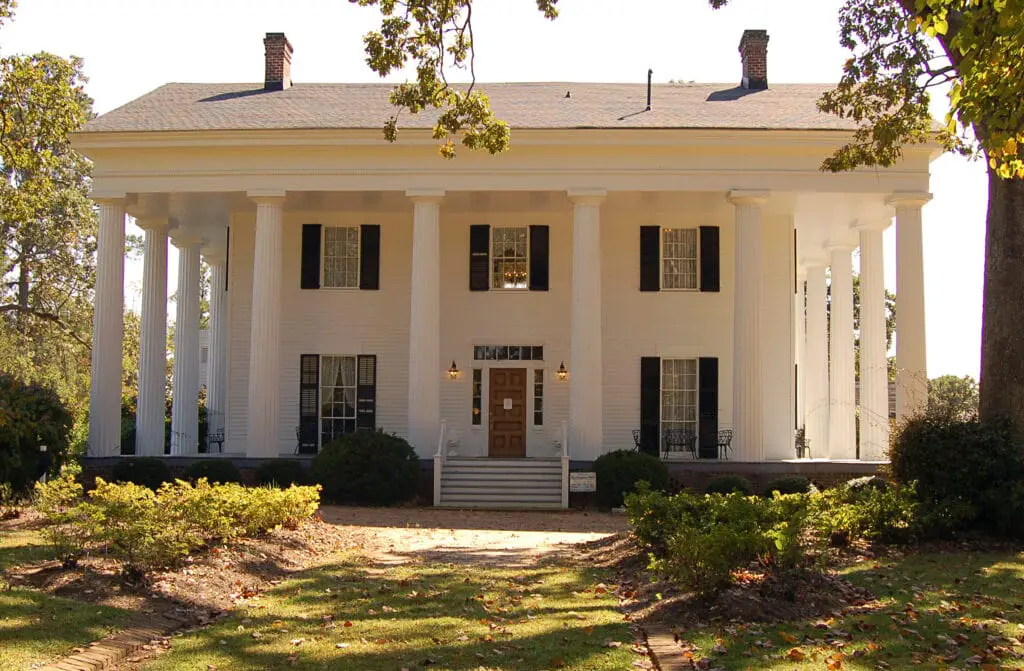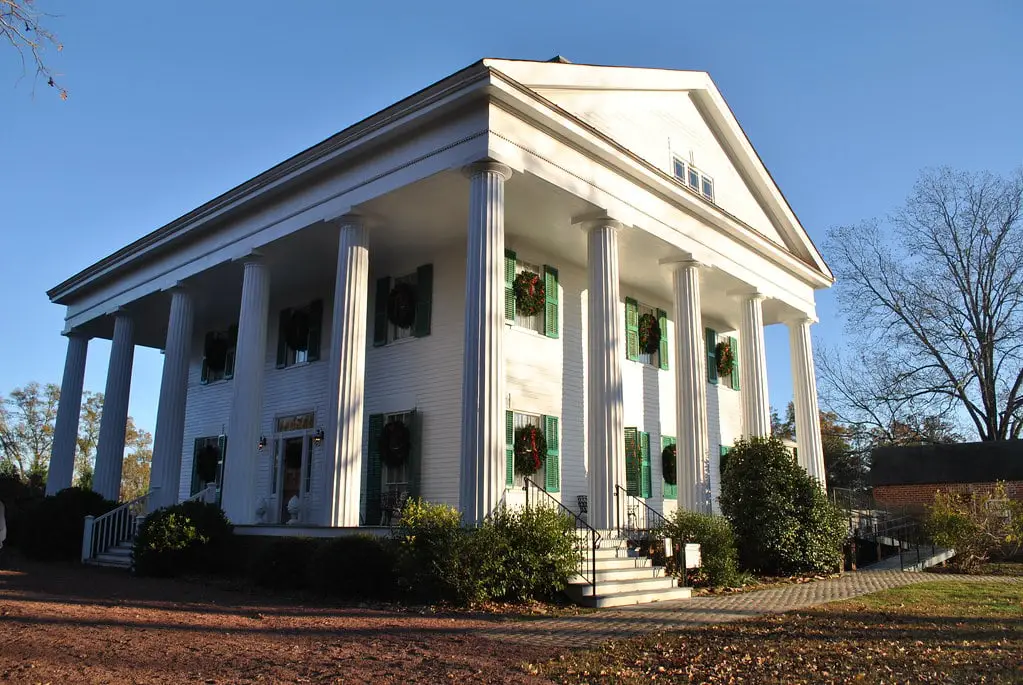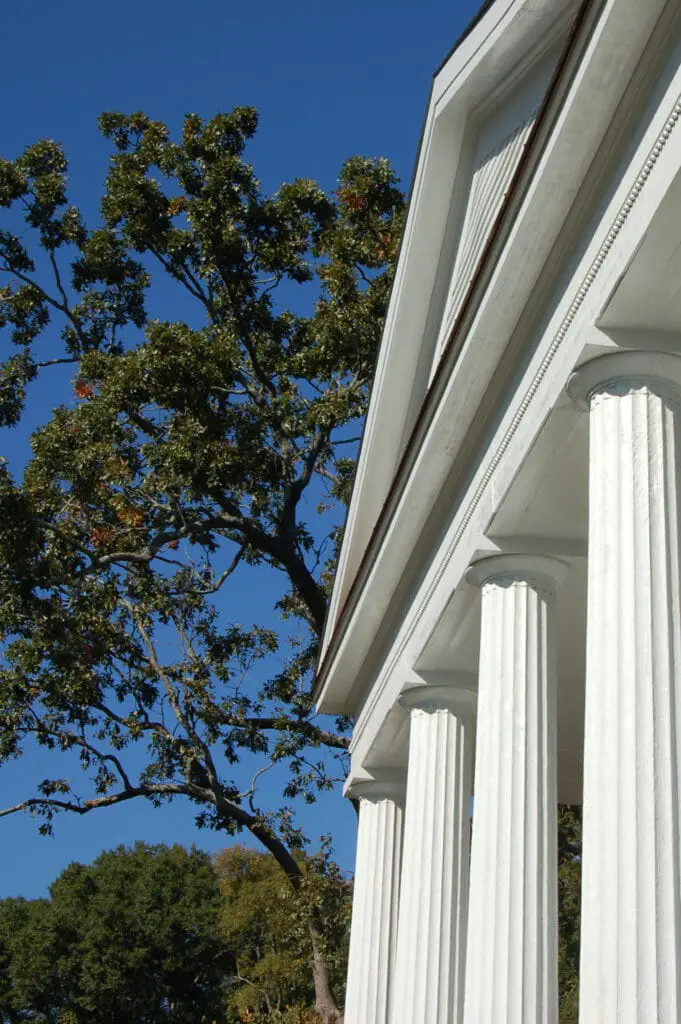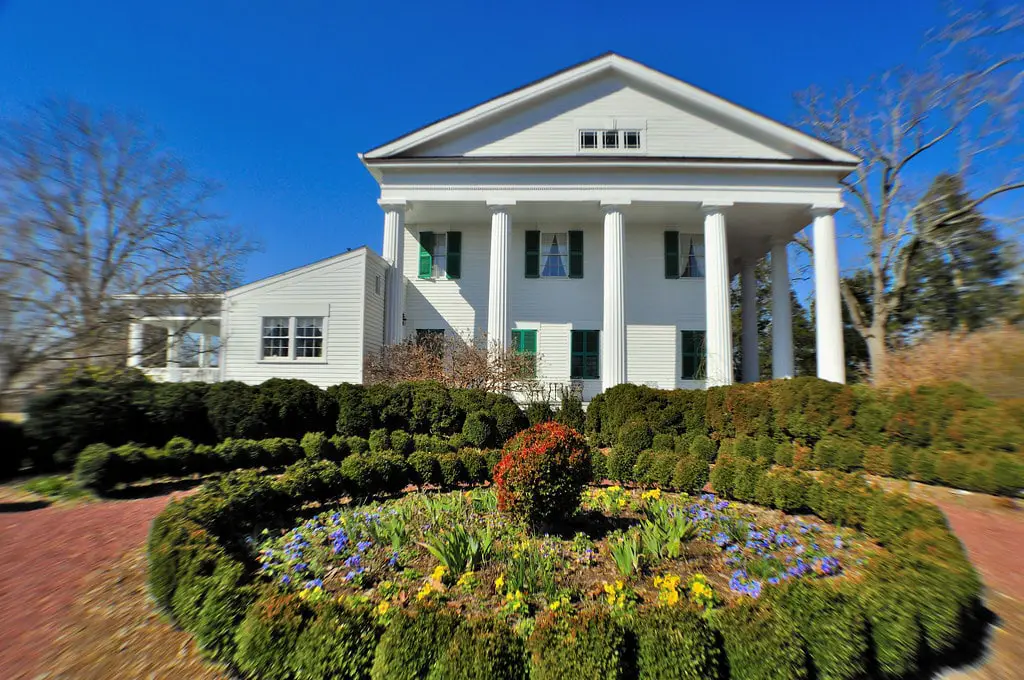The Historical Significance of Barrington Hall
Barrington Hall, a majestic testament to Greek Revival architecture, is a pivotal landmark in Roswell, Georgia. Constructed in 1839, this exquisite structure was designed by the notable architect Willis Ball.
Barrington Hall's architectural beauty and rich historical narrative have rightfully secured its place on the National Register of Historic Places, underscoring its importance in the tapestry of American history.
The hall's inception dates back to the early 19th century, marked by architectural innovation and cultural development.
The Greek Revival style, characterized by its grand columns and symmetrical design, was popular for American homes, particularly in the South.
Barrington Hall's imposing Doric columns and expansive six-acre estate are prime examples of this architectural trend.
The design reflects the era's aesthetic preferences and symbolizes its original inhabitants' prosperity and social status.
Beyond its architectural allure, Barrington Hall is deeply intertwined with the history of Roswell itself.
The hall was the residence of Barrington King, co-founder of Roswell, and his family.
In collaboration with his father, Roswell King, Barrington King founded the town during the 1830s.
They envisioned a flourishing community, anchored by the Roswell Manufacturing Company, which emerged as a key player in the town's economic landscape.
This company, pivotal in the development of Roswell, was instrumental in harnessing the water power of Vickery Creek, thereby catalyzing the town's growth and prosperity.
The hall's significance extends to its role in the broader narrative of the American South.
During a tumultuous period in American history, Barrington Hall witnessed the Civil War and the Reconstruction era.
Its walls have absorbed stories of prosperity, struggle, and resilience, making it a southern heritage and history repository.
Acknowledging its architectural grandeur and historical importance, Barrington Hall earned a spot on the National Register of Historic Places on December 9, 1971.
This inclusion acknowledges the hall's past and ensures its preservation for future generations.
The hall's listing is a nod to its role in the tapestry of American history, safeguarding its legacy and maintaining its status as a cultural and historical icon.
Today, Barrington Hall is more than just a historical monument; it's a vibrant part of the Roswell community.
It has been restored and furnished with period and family pieces, offering visitors and locals a glimpse into the past.
As one of the things to do in Atlanta, Georgia, touring Barrington Hall provides an immersive experience into the rich tapestry of American history, architecture, and culture.
Its continued preservation and public accessibility make it a living museum, bridging the gap between past and present and offering a tangible connection to the history of Roswell and the American South.
The Founding of Roswell and Barrington Hall
The Genesis of Roswell
The story of Roswell, Georgia, is inextricably linked to the establishment of Barrington Hall.
In the late 1820s, Roswell King, a figure of significant influence in the Georgian banking sector, notably with the Bank of Darien, ventured into the northern part of the state.
Initially driven by the bank's interests in the burgeoning gold fields, his journey led him to discover the area that would later become Roswell.
Struck by the natural beauty and the potential of Vickery Creek for industrial power, King envisioned a prosperous community centered around textile production.

Barrington King's Vision
In 1836, Roswell King returned with his son, Barrington King, to actualize this vision.
They founded the Roswell Manufacturing Company in 1839, a pivotal establishment in the town's history.
This company, leveraging the power of Vickery Creek, became a beacon of industrial progress in the region.
The King's foresight in creating a company town was a progressive move, attracting investors and settlers.
Those who heeded the call were influential families like the Smiths, the Bullochs, and the Dunwodys, who played crucial roles in the town's development.
The Construction of Barrington Hall
Barrington Hall's construction began in the 1830s, culminating in its completion in 1842.
Chosen for its strategic location on the highest point in Roswell, the Hall symbolized the King family's status and the town's prosperity.
Willis Ball, an architect renowned for his expertise in Greek Revival architecture, was commissioned to design the Hall.
This architectural choice reflected the contemporary aesthetic trends and symbolized a connection to classical ideals, a theme prevalent in the Antebellum South.
The King Family Legacy
Barrington King and His Family
Barrington King, alongside his wife, Catherine, became a prominent figure in Roswell.
Their residence, Barrington Hall, was not just a home but a social and cultural hub in the town.
The couple raised their family here, with their children growing up amidst Roswell's development.
The King family's influence extended beyond their immediate community, impacting the broader socio-economic landscape of the region.
The King's Contribution to Roswell
The King family's legacy in Roswell is marked by more than just Barrington Hall.
Their involvement in the Roswell Manufacturing Company significantly shaped the town's economy and social structure.
This company was a business venture and a catalyst for community development, attracting workers and their families and contributing to the town's growth.
The Civil War and Its Impact
The Civil War brought significant challenges to the King family and Roswell.
Several of Barrington King's sons served in the Confederate Army, with the family enduring the hardships of the war.
The conflict's end brought about a reconstruction and recovery period, during which the King family played a role in rebuilding the community.
Their efforts during this tumultuous period were instrumental in preserving Roswell's heritage and laying the groundwork for its future growth.

The Civil War Era and Barrington Hall
Barrington Hall During the Civil War
The Civil War era marked a tumultuous period in the history of Barrington Hall and Roswell.
In the summer and fall of 1864, the town of Roswell was occupied by Union troops, a significant event in Hall's history.
According to family tradition, Union General Kennar Gerrard briefly occupied Barrington Hall during this time.
Like many in the South, the King family faced the harsh realities of war, with the Roswell Manufacturing Company playing a crucial role in the Confederate war effort by supplying textiles.
The King Family's Ordeal
The King family, deeply rooted in the Confederacy, faced personal and economic challenges during the Civil War.
The conflict directly impacted Barrington King and his sons.
The war threatened their business interests and brought personal loss and hardship.
The family's resilience during this period was a testament to their commitment to Roswell and their way of life.
Post-War Reconstruction and Challenges
The end of the Civil War ushered in a reconstruction period for Roswell and Barrington Hall.
The King family returned to a changed landscape, both literally and figuratively.
The post-war era was marked by efforts to rebuild and restore the community and the family's businesses.
Tragically, Barrington King's life was cut short soon after the war following an injury caused by his horse.
His death marked the end of an era for Barrington Hall and the beginning of a new chapter in its history.
The Preservation of Barrington Hall
The Baker Family's Role
Following Barrington King's passing, his daughter, Eva, and her spouse, Rev.
William Baker, took up the duty of maintaining Barrington Hall.
The Bakers moved back to Barrington Hall in 1883 to care for older people, including Catherine King.
Following Catherine's death in 1887, the Bakers purchased the property, ensuring its continuation within the family.
Their tenure at Barrington Hall was marked by efforts to maintain the property and its legacy.

The Simpson Sisters' Contribution
In 1929, Barrington Hall was purchased by Eva Baker's granddaughters, Evelyn and Katharine Simpson.
Neither sister married, dedicating their lives to the preservation of the Hall.
Their efforts were crucial in maintaining the integrity and historical significance of the property.
Evelyn Simpson's death in 1960 and Katharine's in 1995 marked the end of an era, with the Hall being preserved for over a century by the direct descendants of Barrington King.
Transition to Public Ownership
The preservation efforts for Barrington Hall took a significant turn when Katharine Simpson adopted Lois Carson, ensuring the Hall's legacy would continue.
Following Katharine's death, Lois Carson became the owner and continued the preservation efforts.
In 2005, the City of Roswell purchased Barrington Hall from Sarah Winner, who had bought it from Lois Carson.
This transition marked the beginning of a new chapter for Barrington Hall, transforming it from a private residence to a public historical site, ensuring its preservation and accessibility for future generations.
Barrington Hall Today
A Living Museum
Since its acquisition by the City of Roswell in 2005, Barrington Hall has been transformed into a vibrant house museum.
This transition marked a significant shift in the Hall's history, from a private family residence to a public cultural and historical site.
The museum offers daily tours, providing visitors with an immersive experience of the 19th-century lifestyle and the history of the King family.
The Hall, meticulously restored and furnished with original family possessions, serves as a window into the past, offering insights into the era's social and cultural norms.
Educational and Cultural Hub
Barrington Hall has become a center for educational and cultural activities in Roswell.
The museum organizes diverse events throughout the year, appealing to those fascinated by history, architecture, and the arts and welcoming families and individual enthusiasts.
These events range from historical reenactments and lectures to cultural festivals and community gatherings.
The Hall's role as an educational hub is further enhanced by its programs designed for school groups, offering students a hands-on experience in learning about local history and heritage.
Public Accessibility and Community Engagement
The City of Roswell's stewardship of Barrington Hall emphasizes public accessibility and community engagement.
The Hall's grounds and gardens are open to the public, providing a serene environment for visitors to explore and enjoy.
The city's efforts to maintain and promote Barrington Hall have ensured that this historical landmark remains a vital part of Roswell's cultural landscape, attracting visitors from across the region and contributing to the city's historical tourism.

The Gardens and Grounds of Barrington Hall
The Historical Gardens
The gardens of Barrington Hall are a significant aspect of the property, reflecting the horticultural practices and aesthetic preferences of the 19th century.
Originally designed by Catharine King, the gardens have been restored and maintained, preserving their historical integrity.
The formal East Garden, with its boxwood parterres and flowering plants, is a highlight, offering a glimpse into the gardening trends of the period.
The Antebellum Public Garden
Barrington Hall is home to the only antebellum public garden in the greater Atlanta area.
With its historical plantings and layout, this garden provides a unique educational opportunity for visitors to learn about antebellum garden design and plant species.
The garden's maintenance and restoration efforts have been collaborative, involving horticulturists and historians, ensuring it remains true to its historical roots.
A Venue for Events and Activities
The gardens and grounds of Barrington Hall are not just historical exhibits; they serve as active spaces for community events and activities.
The grounds provide a picturesque setting for various events, from garden tours and horticultural workshops to outdoor concerts and weddings.
The garden's role in community engagement underscores the importance of Barrington Hall as a multifaceted historical site, blending its rich past with contemporary relevance.

Over 40 years ago, my friend and I met Lois Carson and Katherine Simpson when Barrington Hall was in poor condition. It needed restoration. The yard was filled with chickens and had a vegetable
garden. Both Lois and Katherine were cordial to us. I felt sad that
the house was in such poor condition. I intend to visit it again and\
see it restored.
What a beautiful recollection, thank you for sharing it. You saw Barrington Hall at a moment when few people did.